They are known by many names—aurora glass, dope glass, taffeta glass. They even used to be called, “poor man’s Tiffany”, a disparaging reference to more prestigious glassware.
These glasses have been beautifying homes, used as a statement of affluence from the beginning of the 20th century. This article presents 15 of the most valuable carnival glasses.
You will further learn how to value and price carnival glass. Come with me.
No. |
Carnival glass |
Price |
1 |
Millersburge People’s vase in blue |
$155,000 |
2 |
Northwood Wisteria vase in emerald green |
$140,000 |
3 |
Northwood Peacock and Urn stippled Large ICS Bowl |
$66,000 |
4 |
Northwood Tornado Large Vase in Celeste |
$66,000 |
5 |
Cleveland Memorial Souvenir Ashtray Marigold |
$55,000 |
6 |
Fenton Goddess of Harvest CRE Bowl in Blue |
$52,500 |
7 |
Millersburg Flowering Vine Ruffled Compote in Amethyst |
$50,000 |
8 |
Millersburge Hobster and Feather Vase in Green |
$50,000 |
9 |
Northwood Poppy Show Plate in Aqua Opal |
$45,000 |
10 |
Millersburg Morning Glory Pitcher in Amethyst |
$42,000 |
11 |
Northwood Embroidered Mum’s Carnival glass |
$702 |
12 |
Fenton Carnival Glass Thumbprint Epergne |
$585 |
13 |
Northwood Dandelion Water Set |
$475 |
14 |
Northwood Tree Trunk |
$1,750 |
15 |
Dugan Farmyard Carnival Glass |
$2,100 |
Table of Contents
1. Millersburge People’s Vase in Blue
Price: $155.000
This is the rarest carnival glass ever made and sold. The intricacy is one for the books, almost unmatched by another. The people’s vase was created by John Fenton, the owner of Millersburg Glass. This is one of the 10 that he created in 1910 for the royal family of the Netherlands. The vases were in honor of Queen Wilhelmina. Fenton designed this vase with people dancing, a celebration of the queen’s new baby who would herself become queen.
In 2018, Sieverdes purchased this vase for $155,000.
2. Northwood Wisteria Vase in Emerald Green
Price: $140,000
This rare green vase was made from a water pitcher mold but missing its handles. It was sold in 2018 for $140,000. This vase was made by notable glass specialist Harry Northwood who produced some of the most beautiful glass vases in his Indiana, Pennsylvania plant.
3. Northwood Peacock and Urn stippled ICS Bowl
Price: $66,000
This pressed glass bowl was manufactured anytime between the years 1900—1919. It measures 101/4 inches and when placed by light has a frosty look to it. The bowl has a true yellow base with a beautiful iridescent finish. This bowl lights up the whole room when darkness falls which is what many used them for in the early years of carnival glass. According to experts, this is the second one of its kind. This bowl was valued at $66,000.
4. Northwood Tornado Large Vase in Celeste
Price: $60,000
The Tornado is an extraordinarily rare carnival glass. It is flared into a tricorner top and imbued with iridescence. It sold for $60,000 in 2017 at the Karen Engel auction. Only a few people have ever owned this vase since it was made: George Loescher, George Thomas, Dale Matheny, and Karen Engel.
5. Cleveland Memorial Souvenir Ashtray Marigold
Price: $55,000
This production of this carnival glass was said to commemorate Cleveland, Ohio’s centenary which was founded in 1776. It celebrates five of Cleveland’s architectural wonders of the time. They are depicted in the middle of the ashtray and in the four corners of it. This is a very rare find and any collector who knows his trade and comes across one knows he’s hit top-tier collectible.
6. Fenton Goddess of Harvest CRE Bowl in Blue
Price: $52,500
Another rare find, this bowl displays intricate artistry. The details are so clean and proportionate that they make you marvel at how ingenious the maker was. It depicts the head of a goddess in the middle of the bowl, and ringed around the head is what looks like a wreath of flowers. The goddess herself wears a crown of flowers on her head. It went up for sale at $52,500.
7. Millersburg Flowering Vine Ruffled Compote in Amethyst
Price: $50,000
Like many rare carnival glasses in existence, this one is just one out of a few of its kind. It was an auctioneer’s delight when it went up for sale at $50,000.
8. Millersburge Hobster and Feather Vase in Green
Price: $50,000
Think of a lush green seaweed frozen in the waves of the sea. But made of glass. That’s how this carnival glass looks to me if I’m asked. Any collector would give the world to have this up to their shelf. And you have it, you’d rarely want to sell. This is where antiques get their value off.
According to some sources, this is the only green Millersburge vase in this design known to exist. At an auction, it sold for $50,000.
9. Northwood Poppy Show Plate in Aqua Opal
Price: $45,000
This carnival glass looks almost ethereal. It is an extremely rare glass with a design in the middle that looks more like bursting lava mixed with an assortment of flowers and colors. The plate was sold at auction for $45,000.
10. Millersburge Morning Glory Pitcher in Amethyst
Price: $42,000
Not an ordinary pitcher, it couldn’t be, with all the intricate design. You bet no one wanted to use this carnival glass pitcher to serve tea at breakfast. They are so rare and beautiful that they are on display in some collectors’ homes. This one is finished in amethyst, with an embroidery of flowers on the midsection. It’s got a wide handle done in deep blue. This rare Millersburge pitcher will light up any home or museum. It was sold for $42,000.
11. Northwood Embroidered Mum’s Carnival Glass
Price: $702
It is green, it is iridescent, and has pie crust edges, and behind the glass is signed the eponymous N-in-circle signature that Northwood glasses are known for. Although this glass is not the most valuable on this list, it is by far more valuable than the majority of the glass out there. It is rare as well. It sold for $702.
12. Fenton Carnival Glass Thumbprint Epergne
Price: $702
One of Fenton’s works, the Thumbprint, is one of a kind. It comes in plum opalescence, a ruffled rim bowl with three jack-in-the-pulpit vases. It was made in the second half of the twentieth century. It sold for $702.
13. Northwood Dandelion Water Set
Price: $549
This water set is one of the prettiest-looking carnival glasses in the world. It was manufactured between the years 1920 and 1929. It is iridescent all around, from the tip of the pitcher down to the bottom where the Northwood signature is. It is worth $549.
14. Northwood Tree Trunk Funeral Vases
Price: $1,750
These vases are from the early twentieth century. The pair of vases are 18.5 inches in height, with an amethyst color. They are shaped like an elephant’s feet, thick around the bottom and tapered up the middle to the flared top. Both beauties sold for $1,750.
15. Dugan Farmyard Carnival Glass
Price: $2,100
This carnival glass constitutes one of the most desirable glasses. It is an amethyst bowl with six ruffles and beaded rims. The exterior is a jeweled heart design. It sold for $2,100.
What is Carnival Glass?
Put simply, carnival glass is a type of glass called molded or pressed glass to which an iridescent surface shimmer has been added. Carnival Glass was a name that was adopted by collectors in the 1950s when people started giving out items of it as prizes at carnivals and fairgrounds.
Before the 1950s though, carnival glass served a different purpose for most people. Those who couldn’t afford electric light used carnival glass for the purpose of brightening their homes; people kept carnival glass in corners where its finish caught the light.
From the beginning of the 20th century, most of the carnival glass in circulation was mass-produced in the US. It is still produced in small quantities today.
Carnival glass gets its iridescent shine from the metallic salts that are applied to the surface while the glass is still hot.
Types of Carnival Glass
Carnival glass came to be a mainstream item and many early manufacturers sought to be unique in their designs. These manufacturers include Northwood, Dugan, Fenton, and Millersburg. This gave rise to major patterns or types of carnival glass.
Below are some of the most popular types of carnival glass you will find in circulation today;
Poppy Show Type
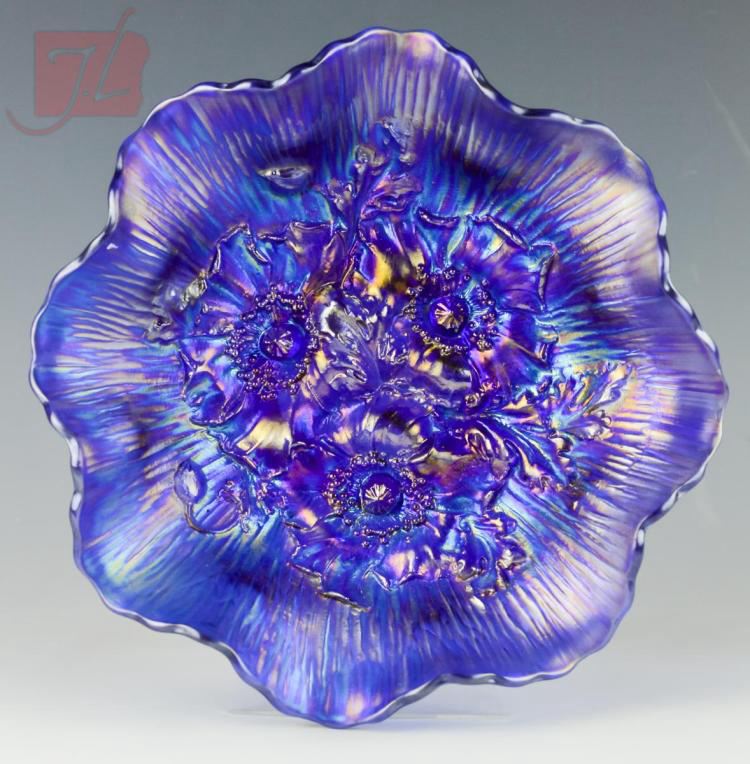
This is one of the most popular types of carnival glass ever made. They were manufactured by Northwood. They are very much desired by collectors. Most of them were made in ruffled bowls and plates with a wide range of colors. Their value is determined by how iridescent they are.
Base colors like green, aqua opal, and ice green are considered rare.
Grape and Cable type
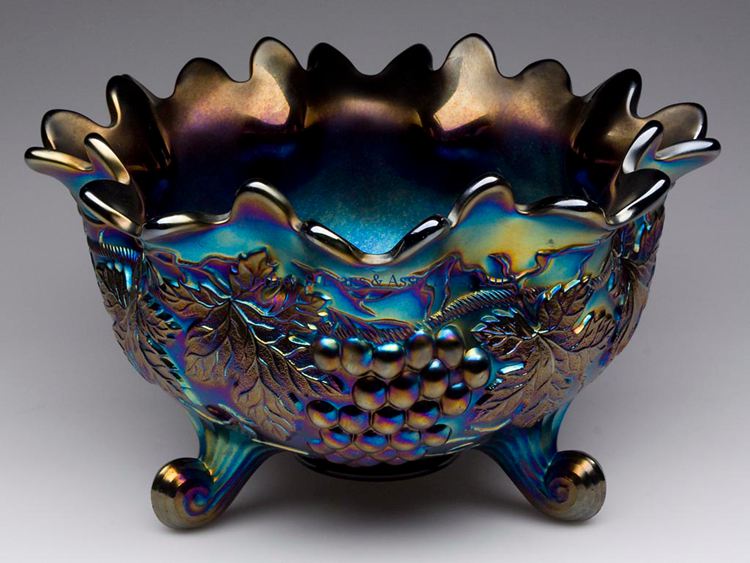
The grape and Cable type of carnival glass is another pattern by Northwood. These types of carnival glasses usually have fruits in their patterns or mold. The one above has grapes. They were either banded or stippled. Northwood made many carnival glasses like this and they were very popular bowls.
Dragon and lotus
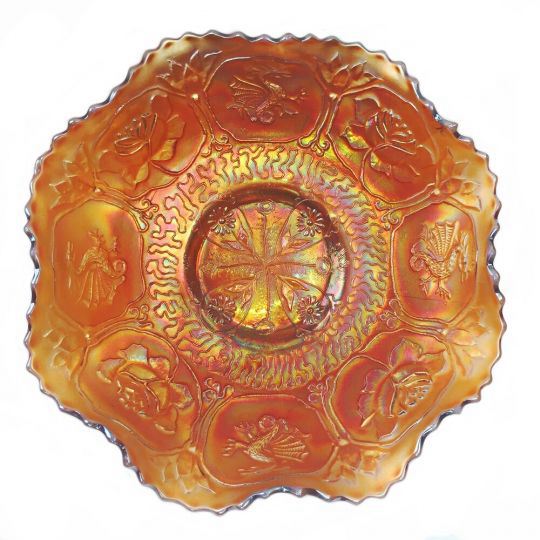
These types of glass were manufactured by Fenton. This Fenton eight ruffle dragon and lotus is a rare find. Although there are other types and patterns of Fenton glasses, this amethyst opal-colored bowl is up there with the other very valuable piece of glass.
Good Luck By Northwood
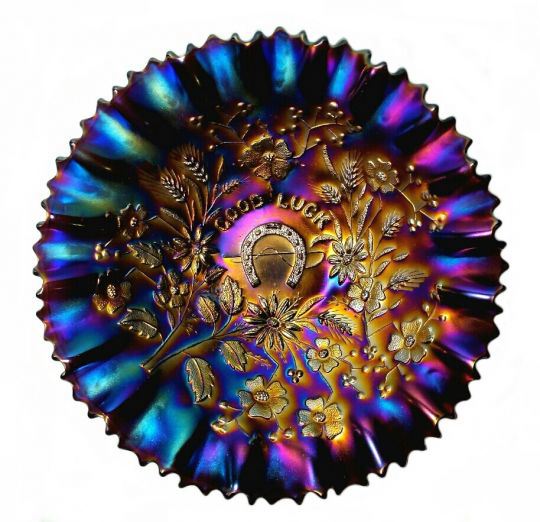
The good luck type of carnival glass is a product of Northwood. They are usually heavy with iridescence. The one above radiates with stunning blue, purple and gold tones. The exterior is also ribbed; with a horseshoe in the middle of a sprinkle of flowers. It also has the basketweave exterior, which is a trademark of this pattern.
Holly Fenton
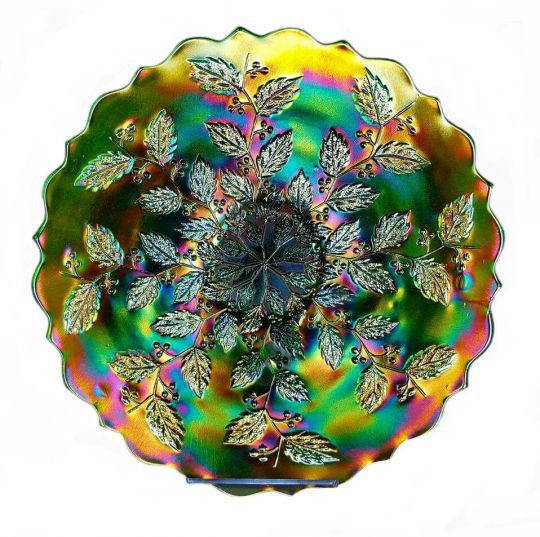
This pattern is from Fenton, it shows a major type of carnival glass you’ll find in online auctions. This is just one out of the several Holly carnival glasses from Fenton, all bearing the same pattern with the only variation being the colors and the design on the outer edges. One peculiar attribute of Holly Fenton is the heavy use of flowers in the design, and the combination of deep, flashy colors. You might say this is something about all carnival glass, and you’d be right.
Types of carnival glass can also be identified by their colors
The Brands of carnival glass
At the height of the popularity of carnival glass, there was a proliferation of manufacturers. The most well-known manufacturers were in the United States of America.
In time each one of these manufacturers came to be identified by their own brands of glass. The most popular brands were:
- Indiana Glass
- Imperial Glass Company
- Northwood
- Millersburg
- Fenton
- Dugan (Diamond) Glass Company
- Cambridge
- US Glass Company
- Westmoreland
Indiana Glass
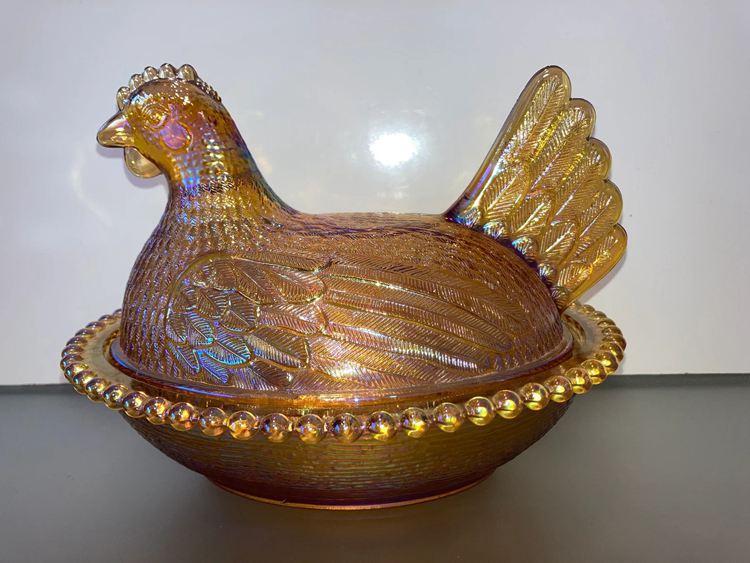
From 1907 the Indiana Glass Company produced pressed, blown, and hand-molded glassware. They made many types of glass which included depression glass and carnival glass. Starting in the mid-1970s Indiana Glass Company began making carnival glass. The colors that the company made carnival glass in were mostly blue, amber, green, and marigold. The company made many types of dishes, compotes, bowls, and vases. Their most notable design was the “Hen on Nest” dishes pictured below.
Imperial Glass Company
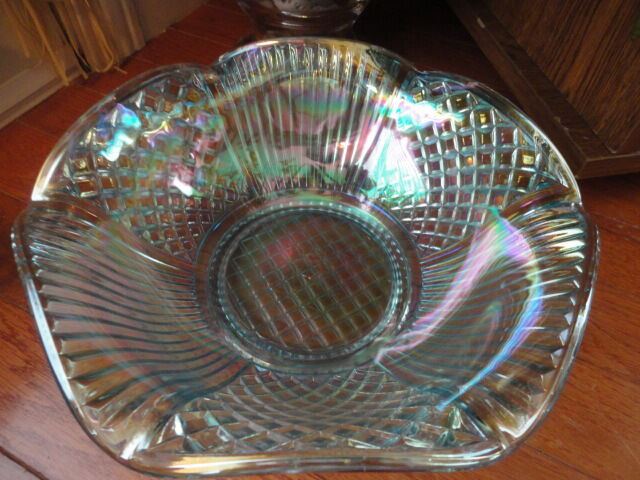
The Imperial Glass Company is located in Bellaire, Ohio. It was founded by Edward Muhleman in 1901. Some sources say this company started producing their own brand of carnival glass in 1910 although there’s evidence to show they may have been manufacturing carnival glass earlier than this.
The brand of Carnival Glass produced by imperial glass used geometric cut patterns in more naturalistic ways than most other producers. The Imperial Ripple Vase was one of their most productive lines from 1910 to 1929. Their classics included the Helios, purple, amber, smoke, vibrant marigold, scarce vaseline, and rare red.
Northwood
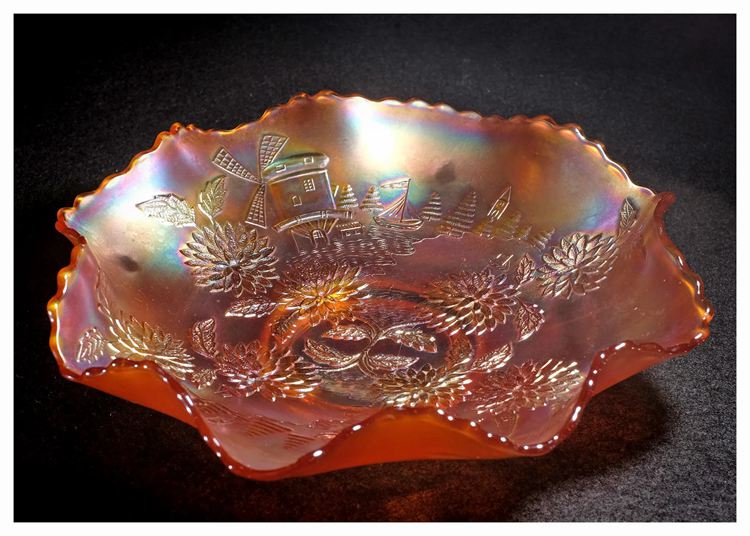
This company was an important innovator in the field of carnival glass. It was founded by Harry Northwood in They started producing carnival glass in 1887 in martins ferry Ohio.
The golden iris was the first Carnival Glass Northwood made. Then he went on to make marigold colors which the company was well known for. Other treatments by Northwood were emerald, azure, Florentine, Perl, and Pomona.
Their base colors were cobalt blue, green, and amethyst. Of all the carnival glassmakers, Northwood was perhaps the most distinguished. The company created a maker mark that was unmistakable, the N inside of a circle under the glass. Below is a Northwood marigold.
Millersburg
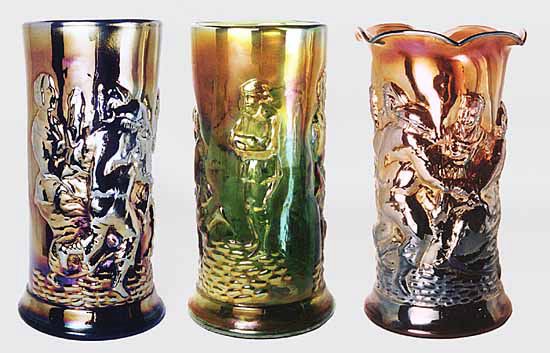
An extremely short-lived company, Millersburg was founded in 1908 by John W. Fenton, the brother of Frank L. Fenton who owned Fenton glass. They made high-quality glass for a short period of time. This shortness has worked in the favor of Millersburg carnival glass since they are scarce and sought after by collectors.
Millersburg carnival glasses are known for their shiny multicolored iridescent “Radium”. They produced three colors mostly; marigold, amethyst, and green and they were mostly bowls and water sets. Their most sought-after carnival glass and rarest of glass is the Millersburg People’s Vase.
Fenton
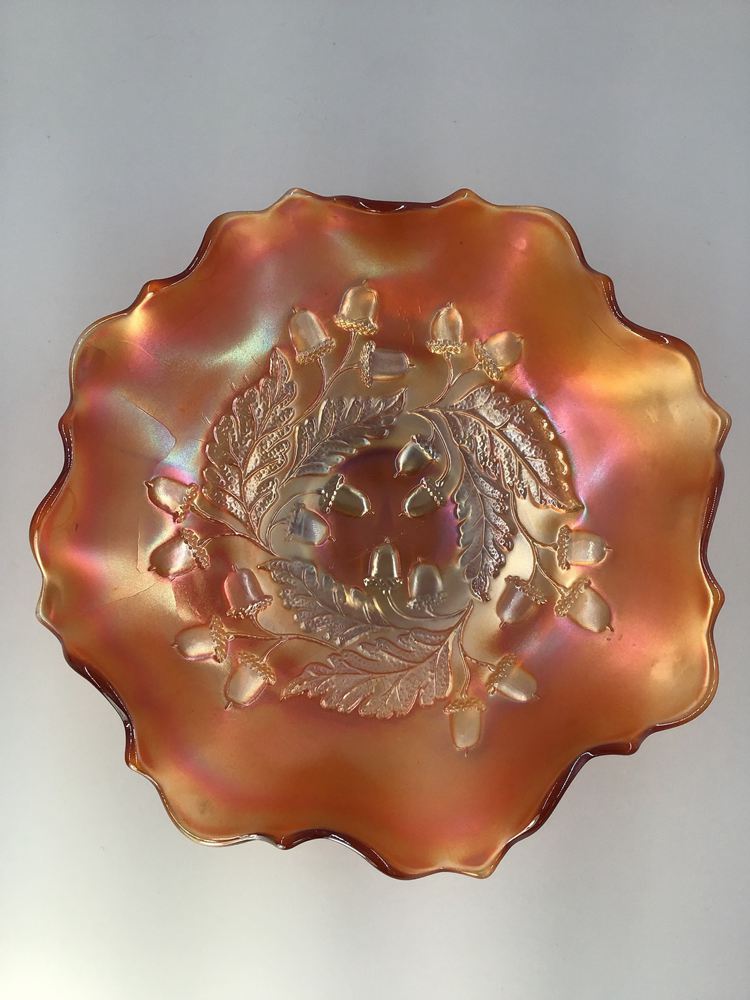
The first year for glass production for the Fenton Glass Company was 1907. This was after a series of changes, from painting blank glass produced by other companies to moving from their former location to a new one in Williamstown, Virginia. Frank Fenton was the designer and decorator.
Their designs were greatly influenced by Tiffany and Steuben. In 1907, the Fenton brothers were the first to introduce carnival glass. Patterns associated with Fenton are, cherry chain, coin dot, dragon and lotus, hobnail, open edge, panther, and Persian medallion. There were hundreds of colors from Fenton too, they include, amberina, amethyst, blue, cobalt blue, green, marigold, red, and rich marigold. Below is a picture of the Fenton marigold.
Dugan (Diamond) Glass Company
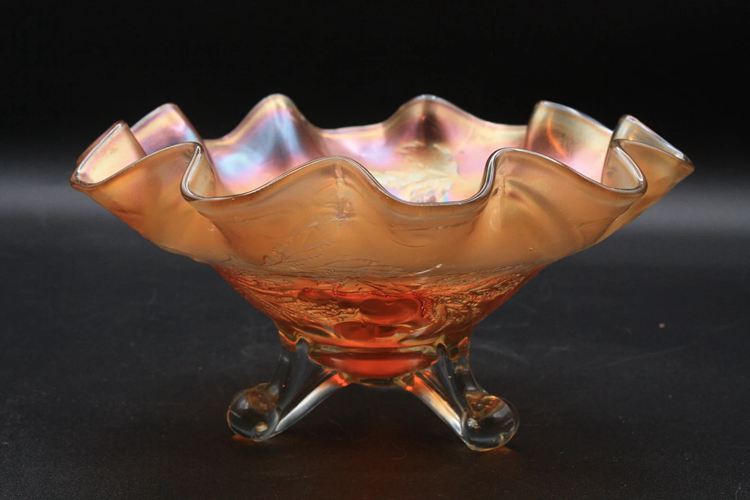
This company was founded by Thomas Dugan, a cousin of Harry Northwood, in 1904 when Dugan bought the closed-down Northwood factory in Indiana. Dugan glass company is notably known for peach opalescent, a type of carnival glass which they produced more than any other company at the time.
They produced deep amethyst colors that looked black, deep crimped edges, iridescent frit glass. Their patterns included Adam’s Rib, Four Flowers, Petal and Fan, Six Petals, and Ski Star. Below is a Dugan Cherries Iridescent Carnival Glass Antique Three Footed Bowl.
Cambridge

The Cambridge glass company was founded by a bunch of businessmen in Cambridge, Ohio. The company produced carnival glass in the 1920s. Below is an image of carnival glass by Cambridge glass.
US Glass Company
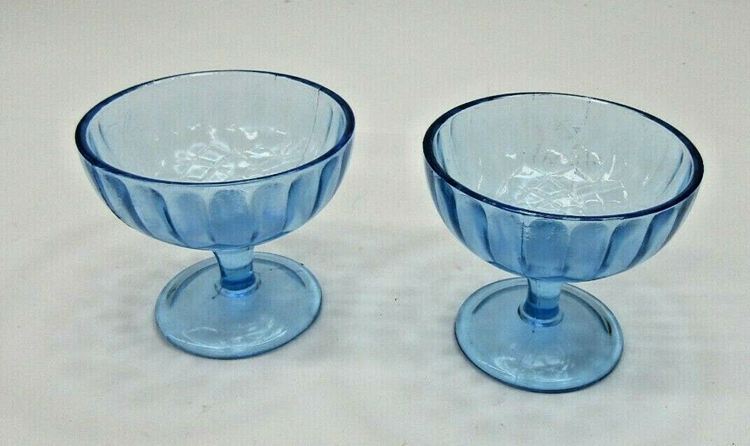
18 different factories came together to form the US Glass Company as a trusted company. This was around 1891. The company produced all manner of glass. There was no particular pattern since different companies were producing under one blanket. The carnival glass pattern that was produced includes Athenia, Cosmos and Cane, Diamond and Daisy Cut, Headdress, Jacob’s Ladder, Palm Beach, Pineapple and Fan, and Whirling Star. Below is a US Glass Company carnival glass.
Westmoreland
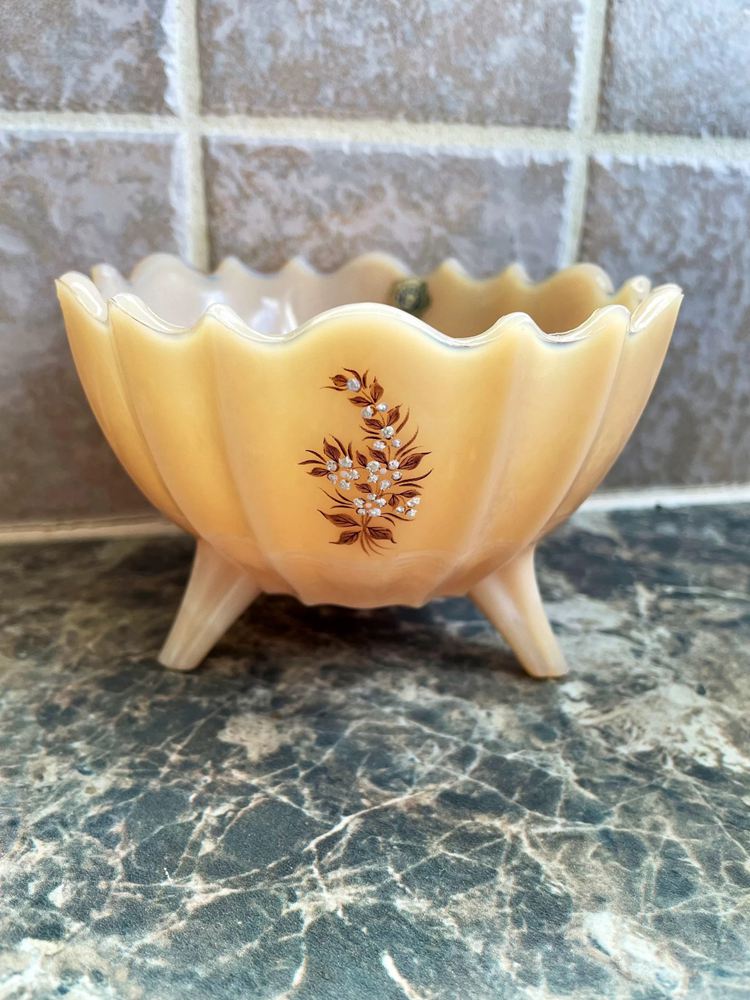
This company was founded in 1889 after a group of men purchased a formerly existing
company called Specialty Glass Company located in East Liverpool, Ohio. Beginning in 1908, Westmoreland produced carnival glass. The patterns the company produced includes Paneled Grape, Beaded Grape, American Hobnail, Old Quilt, and many more. Below is Westmoreland Peach Glass Footed Candy Dish Enamel White Flower design.
How To Identify Carnival Glass
Below is a guide for the most popular carnival glass makers.
Common Carnival Glass Manufacturers Identification
1. Fenton
Color: Amberina, cobalt blue, amethyst, marigold, green and red
Pattern: Butterfly and Berry, lion, panther, dragon and lotus, orange tree, chrysanthemum, water Lily, Grape and Cable, little flowers
Pieces and shapes: Water sets, table sets, bowls, mugs, vases and plates
2. Northwood
Color: Green, amethyst and cobalt blue. Ice green, white, ice blue.
Pattern: Cherry and cable, corn, feathers, grape and Cable, three fruits, wishbone
Pieces and shapes: Bowls, vases and sets
3. Imperial
Color: Helios( metallic silver-gold light green color unique to imperial) purple, amber, smoke, vibrant marigold
Pattern: Flowers, fruits
Pieces and shapes: Bowls, plates, vase, tumbler glasses
4. Millersburg
Color: Marigold, amethyst and green, blue and Vaseline
Pattern: Peacock, pipe humidors, multi-fruits, flower bowls, feathers,
Pieces and shapes: Vases, pitchers, oval bowls,
5. Dugan
Color: Black amethyst, Celeste blue, electric green
Pattern: Ski Star, peach opalescent
Pieces and shapes: Vases, bowls,
6. Westmoreland
Color: Amethyst and emerald green
Pattern: Old Quilt, paneled Grape, beaded grape, American Hobnail
Pieces and shapes: Tumbler, pitcher, dish
7. US Glass
Color: Pastels
Pattern: Athenia, Cosmos and Cane, Diamond and Daisy cut, Headdress, Jacob’s Ladder, Palm Beach, Pineapple and Fan, Whirling Star
Pieces and shapes: Bowls, vases, dish, plates
8. Cambridge
Color: Marigold, green, purple, blue
Pattern: Crystal glass, Waterford crystal, cut glass, sandwich glass
Pieces and shapes: Vase, pitcher, tumbler, jar, goblet, bowl, decanter,
9. Indiana
Color: Blue, amber and gold
Pattern: Princess pattern, hen on nest
Pieces and shapes: Dishes, compotes, vases, bowls
Most common ways to identify a carnival glass
Usually you would need the eyes of a skilled appraiser to identify a carnival glass. But you can also learn how to do this, especially if you’re a budding collector or just a carnival glass enthusiast.
Below are the most common ways to identify a carnival glass.
The color
The iridescent rainbow design is a sure sign that you have a carnival glass in your hands. When held against the light, the color will shimmer and you can easily notice the sheen.
The base of the glass
You can easily tell a carnival glass from the way the bottom or base is different from the rest of the glass. The base does not have the iridescent shimmer of the body of the glass. If it does, know that you have found yourself a fake carnival glass.
The maker’s mark
Although many companies didn’t put a mark on their product, it is still a sure way to tell if it’s a carnival glass or not. Most of the companies who have a mark on their glass use a letter from their name. An example is Northwood.
A Rusty Look
As a carnival glass ages, it becomes rusty on account of the metal oxide used to make it.
Consult a guide
One sure way to ascertain the authenticity of carnival glass is to compare it with an identification guide.
Carnival Glass Antique Value and Price Guide (What is Carnival Glass worth?)
Carnival Glass is commonplace, they can be found in antique stores everywhere. Carnival Glass single pieces can be worth $30 to $50 at auctions. The rarest and most desirable ones can be worth more, even thousands of dollars.
Yet it is sometimes not so easy to be quickly certain about the value of glass without considering different factors like the condition, quality, and the age of the glass. Besides, manufacturers compound the complexity by continuing to make more carnival glass even in modern times and adding their trademark.
Below is a guide that can help you determine the value and price of carnival glass.
Condition
The value of carnival glass can be determined by the condition of the glass. Damages like chips on the edges, and cracks can all reduce the value of carnival glass.
Quality
Carnival Glass was made cheaply in those days but some manufacturers still used quality materials in their pieces. The quality of glass is determined by its iridescent glaze of the glass. It must be completely iridescent, not out in some sections of the glass.
Age
It is not always possible to determine the age of a carnival glass which is why this article has not attempted to date many of the glasses mentioned. However, certain pieces are collectively judged to be more valuable than others. For example, pieces made before 1940 are considered by collectors to be more valuable than those of later years. The reason is a rarity. Most of the glass from before the war is rare.
Shape and size
Some shapes and sizes of carnival glass are rare. For example, the rarest of them are bowls and plates. Most carnival glasses were made in vases instead. Bowls or plates are some of the most valuable pieces.
Color and pattern
The most valuable colors are cherry red, black amethyst, and ice green.
Where To Sell Carnival Glass
Collectors are always on the lookout for antiques to buy. They scour the internet for news of new finds. You can sell your carnival glass in the following ways:
Online
You can sell on the internet by posting it on online marketplaces that specialize in antique sales. There are a number of them like eBay, and Etsy. You can sell your carnival glass in pieces or individually.
Local Auction Company
You can sell at your local auction place if there’s anyone in your area. This is one of the easiest ways to sell your carnival glass and get paid almost instantly.
Sell to individuals or collectors
You can sell to individuals or dealers of carnival glass. Except you know how and where to contact collectors, this may not be so straightforward. But it is also one of the easiest ways to sell your carnival glass.
Frequently Asked Questions
When was carnival glass made?
The Fenton Glass Company originated carnival glass in 1908. It was first called Iridill. It was inspired by blown art glass made by Tiffany and Steuben.
What is the rarest color of carnival glass?
The rarest color of carnival glass is the Fenton Abergina, a deep orange-red tone. This is followed by Northwood marigold, Fenton cherry red, and Northwood black amethyst.
How much is blue carnival glass worth?
Blue carnival glass is worth from $24 to $805 on many auction sites.
What is the most valuable carnival glass?
The Millersburg People’s Vase is the most valuable carnival glass at $155,000.
Final Words
Although it may seem like any old piece of glass, Carnival Glass is a collectible that is worth much more than you think. Although all Carnival Glass can be valuable, judging from shade to shade and piece to piece, there are some that are highly sought after by collectors.
The above is just a sample of the most valuable Carnival Glass. I hope this guide was helpful in aiding you in determining the value and price of your Carnival Glass collection. If you have any additional questions please feel free to post a comment in the comments section and we’ll get back to you asap.

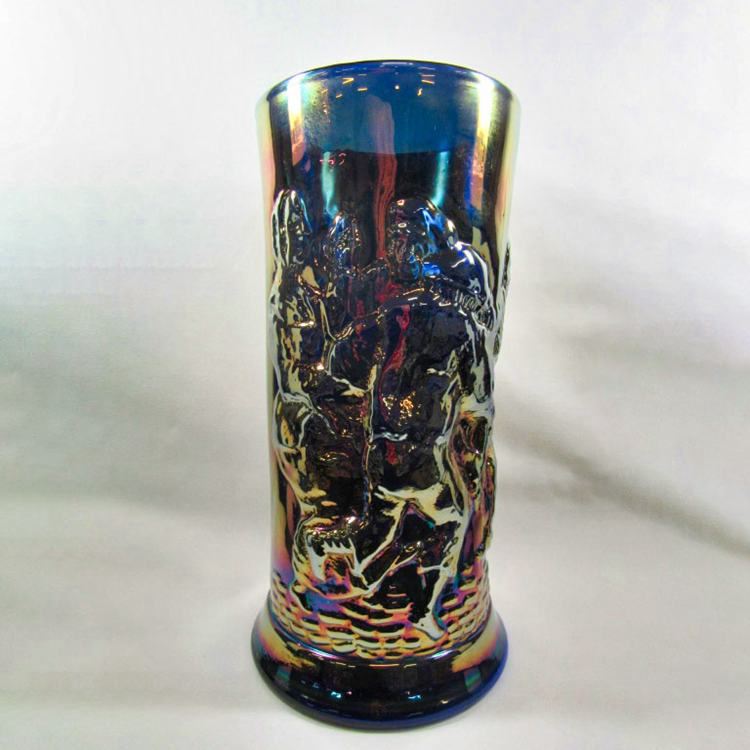
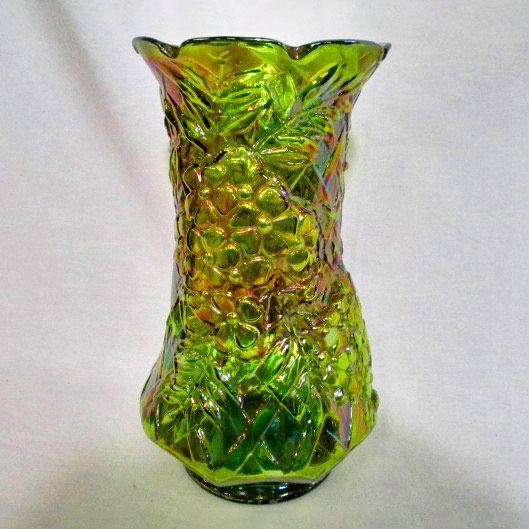
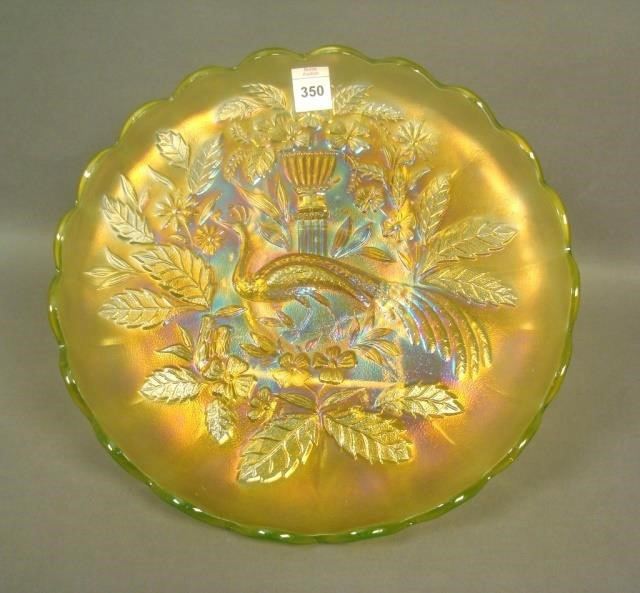
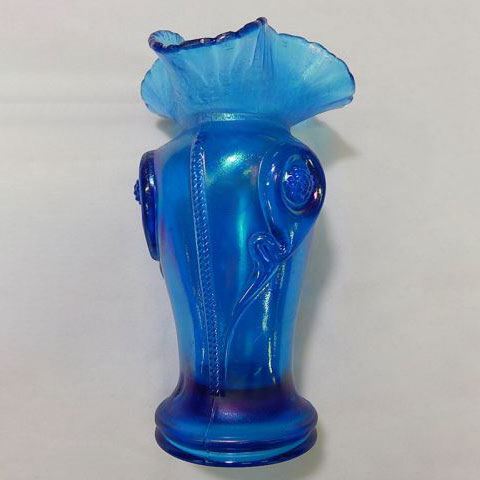
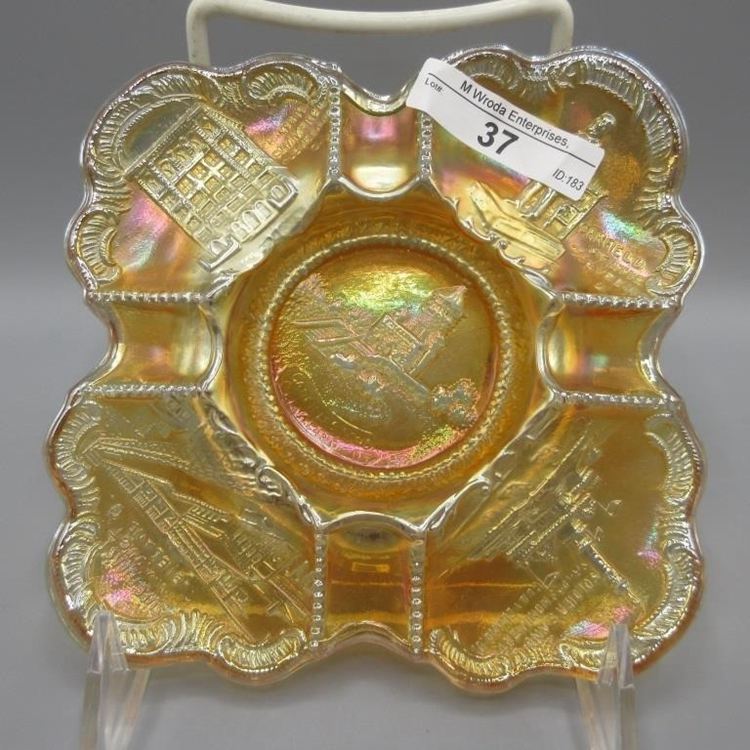
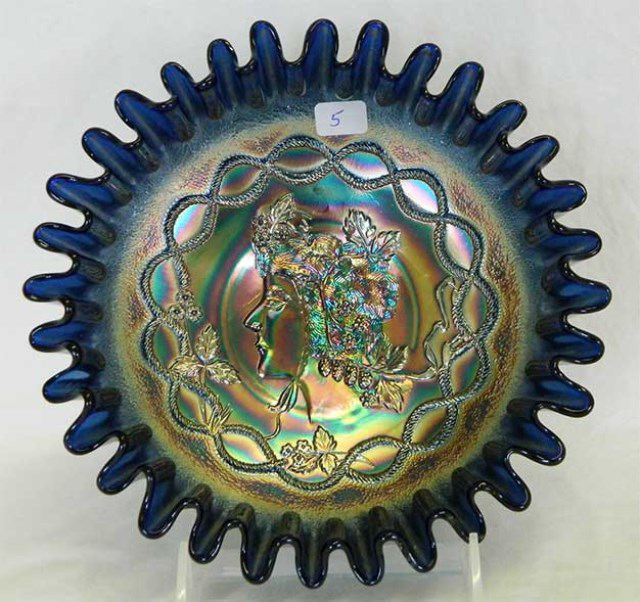
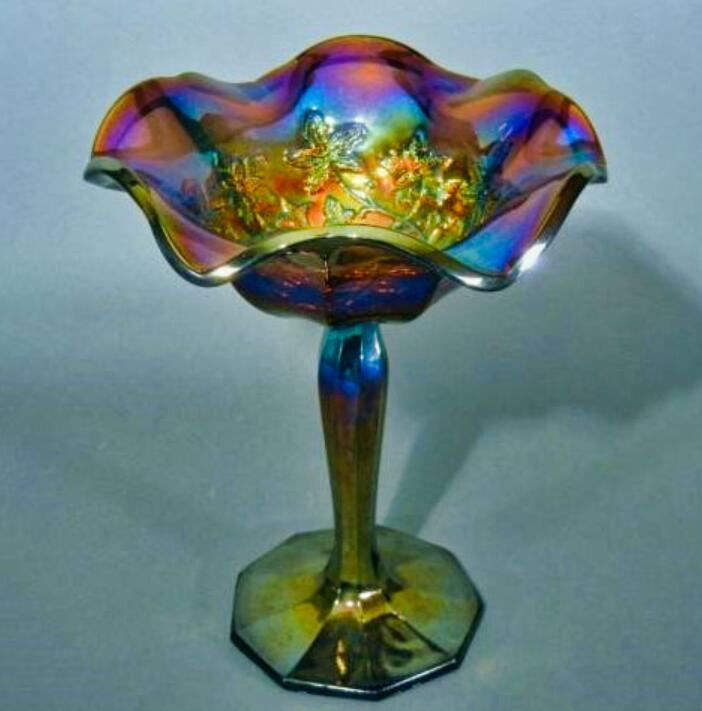
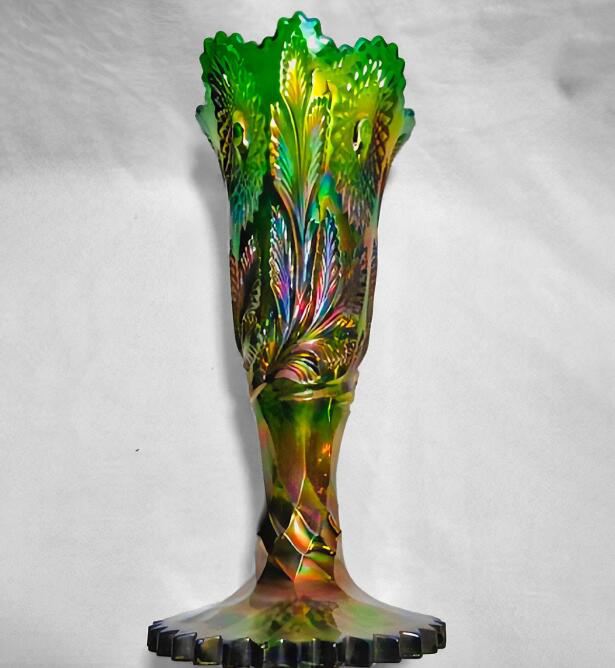
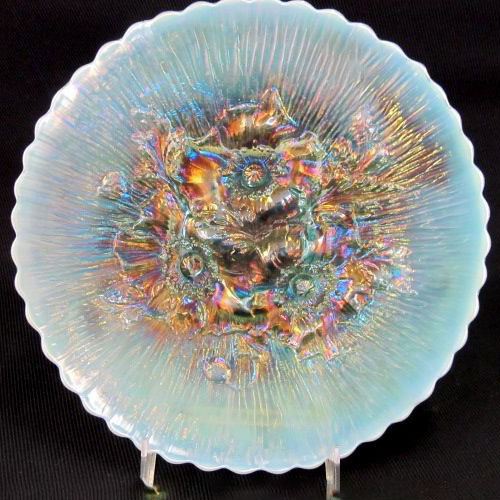
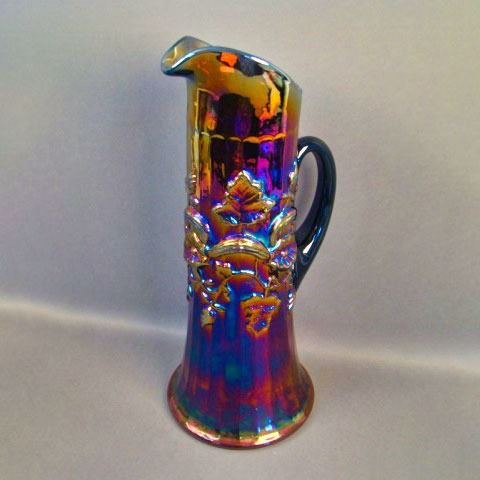
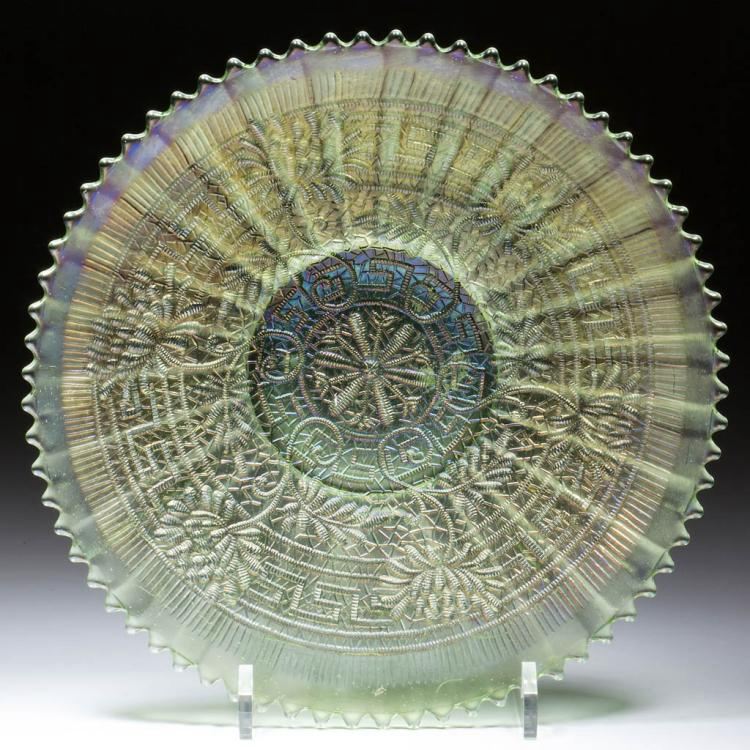
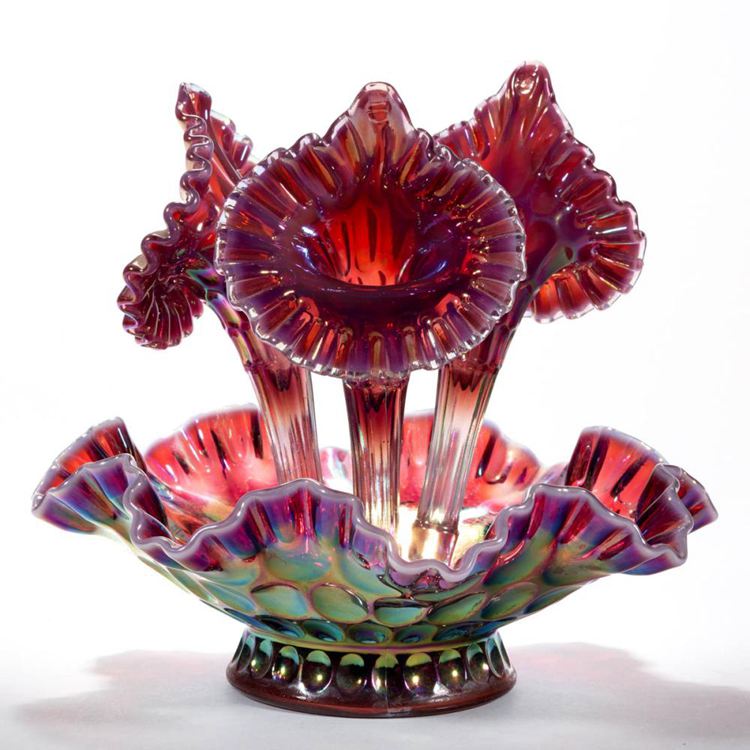
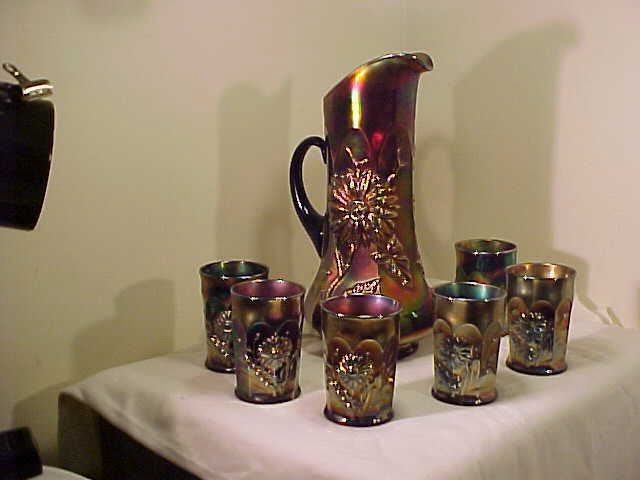
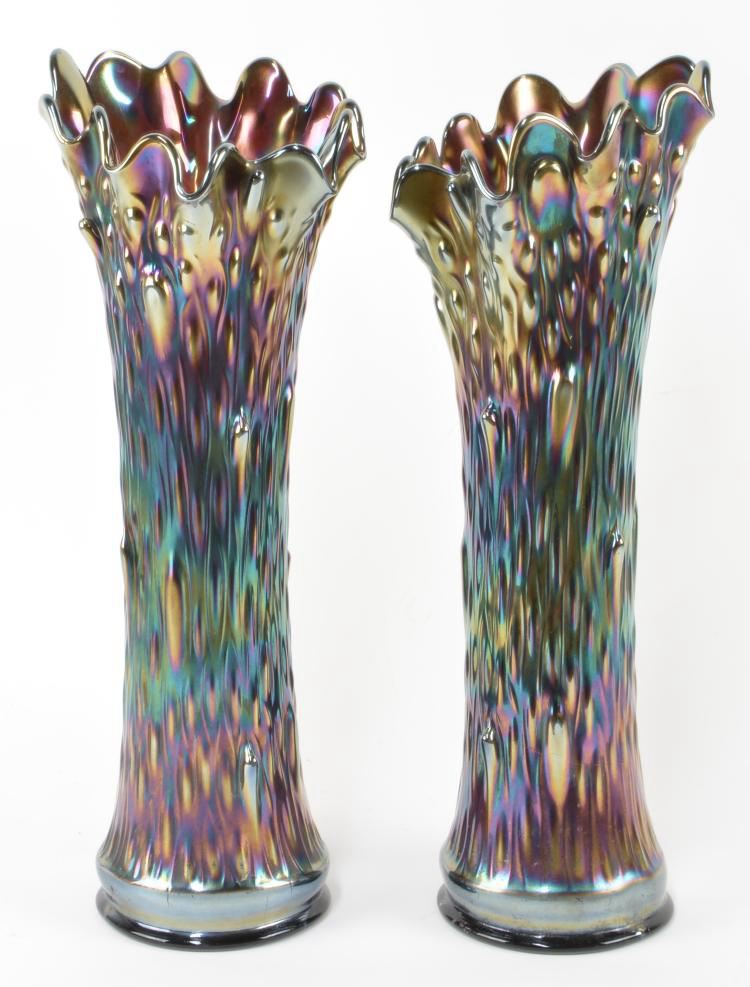
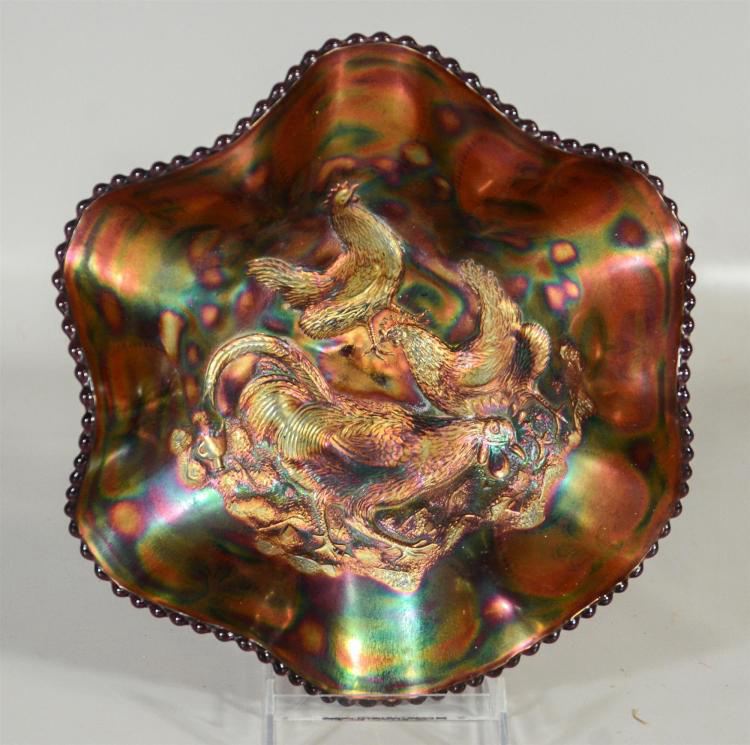




![Where To Sell Antique Furniture In 2022 [Ultimate Guide]](https://www.jacquelinestallone.com/wp-content/uploads/2022/09/Etsy-Your-Place-To-Buy-And-Sell-All-Things-Handmade-600x450.jpg)


